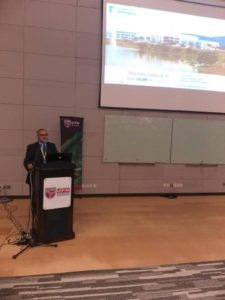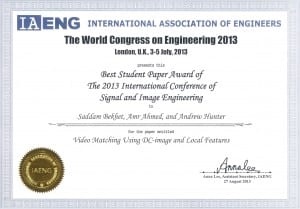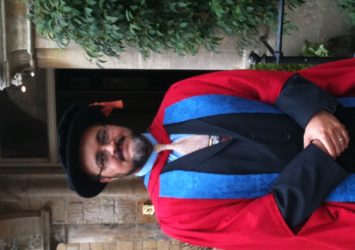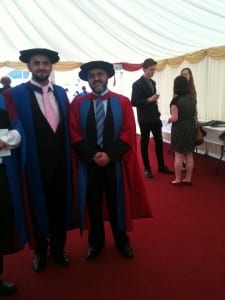 Dr Amr Ahmed, HoS of Computer Science (UNM), was invited as “Keynote Speaker” and “Guest of Honour” to the “International Conference on Advanced Computing Techniques and Applications (ICACTA 2020)” on 5th and 6th March 2020. The conference was held in Bangalore, India, and was organised and hosted by the Reva University. Amr initially delivered a short inaugural speech and then a full keynote speaker, which included an overview of research in the school of Computer Science (UNM). During the inaugural session, Amr was treated with the traditional “Mahraja” hat and robe, as in the photo, which is traditional in Bangalore, India. Amr had various discussions with the organisers and other guests who expressed interest in research collaboration.
Dr Amr Ahmed, HoS of Computer Science (UNM), was invited as “Keynote Speaker” and “Guest of Honour” to the “International Conference on Advanced Computing Techniques and Applications (ICACTA 2020)” on 5th and 6th March 2020. The conference was held in Bangalore, India, and was organised and hosted by the Reva University. Amr initially delivered a short inaugural speech and then a full keynote speaker, which included an overview of research in the school of Computer Science (UNM). During the inaugural session, Amr was treated with the traditional “Mahraja” hat and robe, as in the photo, which is traditional in Bangalore, India. Amr had various discussions with the organisers and other guests who expressed interest in research collaboration.
Plenary Talk: International Conference for Crops Improvement 2019
 Invited to the ICCI2019 (International Conference for Crops Improvement 2019), at UPM (University Putra Malaysia), Dr Amr Ahmed (HoS of Computer Science, UNM) delivered a Plenary talk. The talk titled “Machine Vision & AI; from Health to AgriFood”. The main theme of the conference, this year, was “Sustainability through Data-Driven and Frontier Research”. Closely linked to our research within Computer Science in Nottingham Malaysia.
Invited to the ICCI2019 (International Conference for Crops Improvement 2019), at UPM (University Putra Malaysia), Dr Amr Ahmed (HoS of Computer Science, UNM) delivered a Plenary talk. The talk titled “Machine Vision & AI; from Health to AgriFood”. The main theme of the conference, this year, was “Sustainability through Data-Driven and Frontier Research”. Closely linked to our research within Computer Science in Nottingham Malaysia.
RA Vacancy – 6 months
Short-term RA vacancy:
We have a vacancy for a short-term RA, for up to 6 months. Paid on a rate of up to RM3000 per month, this is suitable for senior PhD researcher who is experienced in Deep Learning and particularly its application in Pathological Image Analysis for detection & classification of Cancer. Candidates are expected to hit the ground running from day 0, given the short period.
Qualified candidates are encouraged to send their CV (highlighting their relevant experience to the above) ASAP, to Dr Amr Ahmed at Amr.Ahmed@nottingham.edu.my
—————
Dr Amr Ahmed
Head of School -Director of the CiH research group
School of Computer Science
University of Nottingham – Malaysia Campus
Jalan Broga, 43500 Semenyih, Selangor Darul Ehsan
Tel: +60 3 8924 8145
—————
Dr Saddam Bekhet, successfully passed viva
Congratulations to Saddam who successfully passed his PhD VIVA on 23rd May 2016.
Examiners have commended Saddam’s work and contributions. They also emphasized how well written the thesis is.
A well-deserved achievement Saddam, well done.
And all the best for your future career.
PhD Studentship – “Object and Action Recognition”
Summary: “Object and Action Recognition Assisted by Computational Linguistics”.
The aim of this project is to investigate how computer vision methods such as object and
action recognition may be assisted by computational linguistic models, such as WordNet.
The main challenge of object and action recognition is the scalability of methods from
dealing with a dozen of categories (e.g. PASCAL VOC) to thousands of concepts (e.g.
ImageNet ILSVRC). This project is expected to contribute to the application of automated
visual content annotation and more widely to bridging the semantic gap between
computational approaches of vision and language.
Deadline: 20th March 2015.
A PhD studentship is advertised at
“Object and Action Recognition Assisted by Computational Linguistics”
The research is collaboration between University of Kingston (Digital Imaging Research Centre) and University of Lincoln (DCAPI group)
For details of the applications process: http://www.kingston.ac.uk/research/research-degrees/funding/phd-studentships-2015/faqs/
Deadline: 20th March 2015
New paper accepted in ICPR 2014 – “Compact Signature-based Compressed Video Matching Using Dominant Colour Profiles (DCP)”
The paper “Compact Signature-based Compressed Video Matching Using Dominant Colour Profiles (DCP)” has been accepted in the ICPR 2014 conference http://www.icpr2014.org/, and will be presented in August 2014, Stockholm, Sweden.
Abstract— This paper presents a technique for efficient and generic matching of compressed video shots, through compact signatures extracted directly without decompression. The compact signature is based on the Dominant Colour Profile (DCP); a sequence of dominant colours extracted and arranged as a sequence of spikes, in analogy to the human retinal representation of a scene. The proposed signature represents a given video shot with ~490 integer values, facilitating for real-time processing to retrieve a maximum set of matching videos. The technique is able to work directly on MPEG compressed videos, without full decompression, as it is utilizing the DC-image as a base for extracting colour features. The DC-image has a highly reduced size, while retaining most of visual aspects, and provides high performance compared to the full I-frame. The experiments and results on various standard datasets show the promising performance, both the accuracy and the efficient computation complexity, of the proposed technique.
Congratulations and well done for Saddam.
Analysis and experimentation results of using DC-image, and comparisons with full image (I-Frame), can be found in Video matching using DC-image and local features (http://eprints.lincoln.ac.uk/12680/)
Dr Amjad Altadmri – Graduation Ceremony
Congratulations to Dr Amjad Altadmri for completeing his PhD degree. Amjad received his PhD degree in the formal September Graduation Ceremony at the Lincoln Cathedral.
His PhD titled “Semantic Annotation of Domain-Independent Uncontrolled Videos, Incorporating Visual Similarity and Commonsesne Knowledge Bases”. The work produced a Framework for semantic video annotation. In addition, VisualNet was also produced, which is a semantic Network for Visual-related applications.
The photo shows Dr Amjad Altadmri (Left) with his Director of Studies/Supervisor Dr Amr Ahmed ( right).
A list of publications of Amjad’s PhD are below:
- A framework for automatic semantic video annotation
Altadmri, Amjad and Ahmed, Amr (2013) A framework for automatic semantic video annotation. Multimedia Tools and Applications, 64 (2). ISSN 1380-7501. - Semantic levels of domain-independent commonsense knowledgebase for visual indexing and retrieval applications
Altadmri, Amjad and Ahmed, Amr and Mohtasseb Billah, Haytham (2012) Semantic levels of domain-independent commonsense knowledgebase for visual indexing and retrieval applications. Neural Information Processing. Lecture Notes in Computer Science, 7663 . pp. 640-647. ISSN 0302-9743 - VisualNet: commonsense knowledgebase for video and image indexing and retrieval application
Alabdullah Altadmri, Amjad and Ahmed, Amr (2009) VisualNet: commonsense knowledgebase for video and image indexing and retrieval application. In: IEEE International Conference on Intelligent Computing and Intelligent Systems, 21-22 November 2009, Shanghai, China.. - Automatic semantic video annotation in wide domain videos based on similarity and commonsense knowledgebases
Altadmri, Amjad and Ahmed, Amr (2009) Automatic semantic video annotation in wide domain videos based on similarity and commonsense knowledgebases. In: The IEEE International Conference on Signal and Image Processing Applications (ICSIPA 2009), 18-19th November 2009, Malaysia. - Video databases annotation enhancing using commonsense knowledgebases for indexing and retrieval
Altadmri, Amjad and Ahmed, Amr (2009) Video databases annotation enhancing using commonsense knowledgebases for indexing and retrieval. In: The 13th IASTED International Conference on Artificial Intelligence and Soft Computing., September 7 � 9, 2009, Palma de Mallorca, Spain..
Amjad has also participated, with Amr and other members of the DCAPI group, in various workshops especially the V&L EPSRC Network workshops. They presented sessions and showed posters; see related blog posts:
- Two Presentations and Posters in the Vision & Language Network workshop (Dec. 2012, Sheffield) : http://amrahmed.blogs.lincoln.ac.uk/2012/12/22/two-presentations-and-posters-in-the-vision-language-network-workshop/
-
V&L Network workshop, Brighton (September 2011): http://amrahmed.blogs.lincoln.ac.uk/2011/09/19/vl-network-workshop-brighton/
Best Student Paper Award 2013 – WCE 2013
Congratulations to Saddam Bekhet (PhD Researcher) who achieved the “Best Student Paper Award 2013″ for his conference paper entitled “Video Matching Using DC-image and Local Features ” presented earlier in “World Congress on Engineering 2013“ in London .


Abstract: This paper presents a suggested framework for video matching based on local features extracted from the DC-image of MPEG compressed videos, without decompression. The relevant arguments and supporting evidences are discussed for developing video similarity techniques that works directly on compressed videos, without decompression, and especially utilising small size images. Two experiments are carried to support the above. The first is comparing between the DC-image and I-frame, in terms of matching performance and the corresponding computation complexity. The second experiment compares between using local features and global features in video matching, especially in the compressed domain and with the small size images. The results confirmed that the use of DC-image, despite its highly reduced size, is promising as it produces at least similar (if not better) matching precision, compared to the full I-frame. Also, using SIFT, as a local feature, outperforms precision of most of the standard global features. On the other hand, its computation complexity is relatively higher, but it is still within the real-time margin. There are also various optimisations that can be done to improve this computation complexity.
Conference paper presented WCE’13 – 3rd July 2013 – London
The paper (titled “Video Matching Using DC-image and Local Features”) was presented by Saddam Bekhet (PhD Rsearcher) in the International Conference of Signal and Image Engineering (ICSIE’13), during the World Congress on Engineering 2013, in London UK.
Abstract:
This paper presents a suggested framework for video matching based on local features extracted from the DC-image of MPEG compressed videos, without decompression. The relevant arguments and supporting evidences are discussed for developing video similarity techniques that works directly on compressed videos, without decompression, and especially utilising small size images. Two experiments are carried to support the above. The first is comparing between the DC-image and I-frame, in terms of matching performance and the corresponding computation complexity. The second experiment compares between using local features and global features in video matching, especially in the compressed domain and with the small size images. The results confirmed that the use of DC-image, despite its highly reduced size, is promising as it produces at least similar (if not better) matching precision, compared to the full I-frame. Also, using SIFT, as a local feature, outperforms precision of most of the standard global features. On the other hand, its computation complexity is relatively higher, but it is still within the real-time margin. There are also various optimisations that can be done to improve this computation complexity.
Well done Saddam.
Conference paper Accepted to the “World Congress on Engineering”
New Conference paper accepted for publishing in “World Congress on Engineering 2013“.
The paper title is “Video Matching Using DC-image and Local Features ”
Abstract:
This paper presents a suggested framework for video matching based on local features extracted from the DC-image of MPEG compressed videos, without decompression. The relevant arguments and supporting evidences are discussed for developing video similarity techniques that works directly on compressed videos, without decompression, and especially utilising small size images. Two experiments are carried to support the above. The first is comparing between the DC-image and I-frame, in terms of matching performance and the corresponding computation complexity. The second experiment compares between using local features and global features in video matching, especially in the compressed domain and with the small size images. The results confirmed that the use of DC-image, despite its highly reduced size, is promising as it produces at least similar (if not better) matching precision, compared to the full I-frame. Also, using SIFT, as a local feature, outperforms precision of most of the standard global features. On the other hand, its computation complexity is relatively higher, but it is still within the real-time margin. There are also various optimisations that can be done to improve this computation complexity.


